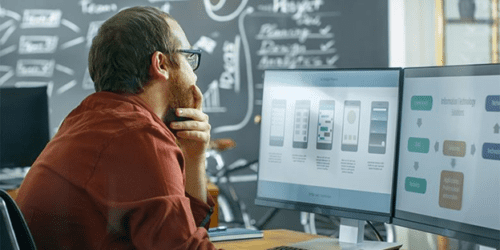
Writing is Designing: Three Principles for Writing Effective UX Copy
Design MarketingImagine, if you will, that you’ve discovered a cute new gem of a bakery. The pastry chef welcomes you into the ambient, delightfully quirky...
It’s one thing to come up with an idea. It’s another to come up with one that works. That’s the thinking behind Design Thinking.
We’ve previously looked at the Design Thinking process and discussed how understanding user needs is key to giving them the experience they’re looking for—which can be key to helping businesses meet their goals. In this post, we’ll take a look at exactly why the Design Thinking framework is so important and shed light on how the process can help you build brilliant digital products that will make a difference for your users and your company.
Design Thinking lets you deliver well-thought-out applications that delight your customers from Day One. By thinking through the process from every angle up front, you keep your reputation intact—and avoid the time and expense of rolling out new features or functionality post-launch.
Design Thinking is, first and foremost, a process. It features steps to follow and a checklist of items to reference. It also allows for enough wiggle room so necessary changes or pivots won’t completely disrupt the project.
What that means for your team is that they have a set path to work along, clear goals to achieve, and which complex problems need solving, providing much-needed structure to your project.
But, things change, experiments don’t work as planned, or new ideas are introduced. The ability to incorporate all the unexpected bits of life is where the Design Thinking process really shines. It’s flexible enough to inspire creative thinking, yet fixed enough to keep the problem-solving on track.
One of the best elements of Design Thinking is that creativity and curiosity can come from anyone. Design Thinking allows for creative thinking from everyone, not just designers and developers. For this process to work, anyone and everyone should be a design thinker. Users and customers are also invited to the Design Thinking table because they are the folks that the process impacts most. The end result is an app that works for everyone involved because everyone has had their say.
Design Thinking keeps you focused on value. By putting the users’ experience first, you’re able to identify any complex problems and can address them with the best possible solutions. And since it offers built-in flexibility, you can afford to make needed adjustments from the start all the way to your app launch date.
The Design Thinking process also helps to keep tech and design debt at bay. By taking a purposeful approach to your app’s design, you’ll find that the design and build can be more sturdy and provide deeper solutions than one built without that vital context.
So now you know all about the benefits of the Design Thinking framework. You might be thinking, how can I make the best use of this approach to innovation? Here are three key takeaways:
We’re a curious bunch at Big Nerd Ranch, full of design thinkers, developers, designers—the list can and does go on. We like nothing more than to get inside the heads of the people who stand to benefit from the digital applications we build. Design Thinking is a powerful tool used by BNR senior-level designers and engineers. Join us at the table. Reach out and let’s get started.

Imagine, if you will, that you’ve discovered a cute new gem of a bakery. The pastry chef welcomes you into the ambient, delightfully quirky...

There are several design patterns used these days in the .NET ecosystem. What are they? What are the benefits and drawbacks of each pattern?...

Large organizations with multiple software development departments may find themselves supporting multiple web frameworks across the organization. This can make it challenging to keep...